Arm Announces Neoverse V1 & N2 Infrastructure CPUs: +50% IPC, SVE Server Cores
by Andrei Frumusanu on September 22, 2020 9:00 AM EST- Posted in
- CPUs
- Arm
- Servers
- Infrastructure
- SVE
- Neoverse V1
- Neoverse N2
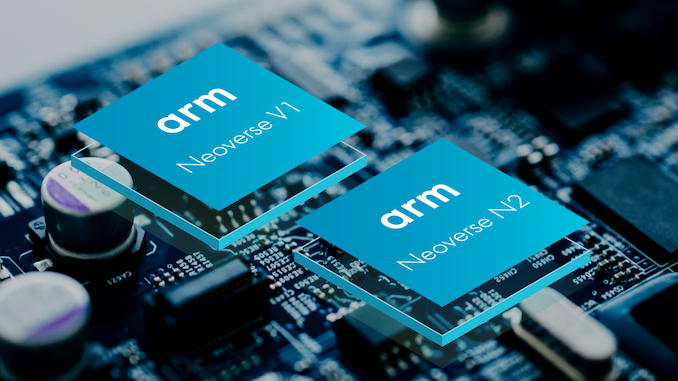
Arm’s ambitions for the server market has been a very long journey that’s taken years to materialise. After many doubts and false start attempts, today in 2020 nobody can deny that sever chips powered by the company’s CPU IP are not only competitive, but actually class-leading on several metrics.
Amazon’s Graviton2 64-core Neoverse N1 server chip is the first of what should become a wider range of designs that will be driving the Arm server ecosystem forward and actively assaulting the infrastructure CPU market share that’s currently dominated by the x86 players such as Intel and AMD.
The journey has been a long one, but has had its roots back in roadmaps publicly planned laid out by the company back in 2018. Fast-forward to 2020, not only have we seen products with the first-generation Neoverse N1 infrastructure CPU IP hit the market in commercial and publicly available form, but we’ve seen the company exceed their targeted 30% generational gain by a factor of 2x.
The Neoverse V1: A New Maximum Performance Tier Infrastructure CPU
Today, we’re ready to take the next step towards the next generation of the Neoverse platform, not only revealing the CPU microarchitecture previously known as Zeus, but a whole new product category that goes beyond the Neoverse N-series: Introducing the new Neoverse V-series and the Neoverse V1 (Zeus), as well as a new roadmap insertion in the form of the Neoverse N2 (Perseus).
The new Neoverse V1 introduces the new V-series into Arm’s infrastructure IP portfolio, and essentially this represents the company’s push for higher absolute performance, no matter the cost.
Earlier this spring we covered the company’s new mobile Cortex-X1 CPU IP which represented significant business model change for Arm: Instead of offering only a single one-fits-all CPU microarchitecture which licensees had to make due with in a wider range of designs and performance points, we’ve now seen a divergence of the microarchitectures, with one IP offering now focusing on pure maximum performance (Cortex-X1), no matter the area or power cost, while the other design (Cortex-A78) focuses on Arm’s more traditional maximised PPA (Power, Performance, Area) design philosophy.
The Zeus microarchitecture in the form of the Neoverse V1 is essentially the infrastructure counterpart to what Arm has achieved in the mobile IP offering with the Hera Cortex-X1 CPU IP: A focus on maximum performance, with a lesser regard to power and area.
This means that the V1 has significantly larger caches, cores structures, using up more area and power to achieve unprecedented performance levels.
In terms of generational performance uplift, it’s akin to Arm throwing down the gauntlet to the competition, achieving a ground-breaking +50 IPC boost compared to Neoverse N1 that we’re seeing in silicon today. The performance uplift potential here is tremendous, as this is merely a same-process ISO-frequency upgrade, and actual products based on the V1 will also in all likelihood also see additional performance gains thanks to increased frequencies through process node advancements.
If we take the conservatively clocked Graviton2 with its 2.5GHz N1 cores as a baseline, a theoretical 3GHz V1 chip would represent an 80% uplift in per-core single-threaded performance. Not only would such a performance uptick vastly exceed any current x86 competition in the server space in terms of per-core performance, it would be enough to match the current best high-performance desktop chips from AMD and Intel today (Though we have to remember it’ll compete against next-gen Zen3 Milan and Sapphire Rapids products).
Neoverse N2 is Perseus – Continues the PPA Focus
Alongside the Neoverse V1 platform, we’ve seen a roadmap insertion that previously wasn’t there. The Perseus design will become the Neoverse N2, and will be the effective product-positioning successor to the N1. This new CPU IP represents a 40% IPC uplift compared to the N1, however still maintains the same design philosophy of maximising performance within the lowest power and smallest area.
It can be a bit confusing when it comes to the microarchitectural generations that we’re talking about here, so I made a graph to illustrate what we could call generational siblings between Arm’s mobile, and server CPU IP:
Although this is just a general rough outline of Arm’s products, the important thing to note that there’s similarities between generations of Cortex and Neoverse products as they’ve being developed in tandem at similar moments in time during their design. The Neoverse N1 was developed in conjunction with the Cortex-A76, and thus the two microarchitectures can be regarded as sibling designs as they share a lot of similarities.
The Neoverse V1 can be regarded as a sibling design to the Cortex-X1, likely sharing a lot of the supersized core structures that had been developed for these two flagship CPUs.
The Neoverse N2 is a bit more special as it represents the sibling design to a next-generation Cortex-A core which is the follow-up to the A78. Arm says they’ll be licensing out this “Perseus” design by the end of the year and that customers already are engaging on beta RTL – we’re likely to hear more about this generation of products at next year’s TechDay event. The N2 would be lagging behind the V1 by one year and subsequently it'll take more time to see this in products.
As a note, all of the above designs are all based in Austin and can be regarded as in the same microarchitecture family that had been started off with the Cortex-A76. If I’m not mistaken, next-generation “Poseidon” designs will be on a fresh new microarchitecture started by Arm’s Sophia-Antipolis design team – although Arm does note that there’s a lot more collaboration and blur between the different teams nowadays. Here Arm already notes a +30% IPC uplift for this generation of designs, likely to hit products in 2023.
An Undisclosed Architecture with SVE: Armv9?
One very notable characteristic of both the Neoverse V1 and N2 are the fact that these now support SVE (Scalable Vector Extensions), with the V1 having two native 256-bit pipelines and the N2 being a 2x128-bit design. The advantage of SVE over other SIMD ISAs is the fact that code written in it can scale with the varying execution width of a microarchitecture, something that’s just not possible with today’s Neon or AVX SIMD instructions.
Fujitsu’s A64FX chip and custom core microarchitecture had been to date the only CPU announced and available with SVE, meaning the V1 and N2 will be Arm’s first own designs actually implementing SVE.
Today’s announcements around this part of the V1 and N2 CPUs raised more questions than it answered, as the company wasn’t willing to disclose whether this support referred to the first-generation SVE instruction set, or whether they already supported SVE2.
In fact, the company wouldn’t confirm even the base architecture of the designs, whether this were Armv8 designs or one of the subsequent iterations. This is extremely unusual for the company as it’s traditionally transparent on such basic aspects of their IPs.
What I think is happening here is that the V1 and N2 might be both Armv9 designs, and the company will be publicly revealing the new ISA iteration sometime between today’s announcement and mid next year at the latest – of course this is all just my own interpretation of the situation as Arm refused to comment on the topic.
Update: Actually it does seem that Arm had already publicly upstreamed the initial compiler entries to GCC for Zeus back in June, confirming that at least the Neoverse V1 is an Armv8.4+SVE(1) design. I still think the N2 might be a v9+SVE2 design.
At the end of the day, what we end up are two extremely compelling new microarchitectures that significantly push Arm’s positioning in the infrastructure market. The Neoverse N2 is an obvious design that focuses on Arm’s PPA metrics, and the company sees customers designing products that are primarily focused on “scale-out” workloads that requite a lot of CPU cores. Here we could see designs up to 128 cores.
The Neoverse V1 will see designs with lesser core-counts as the CPUs are just bigger and more power hungry. Arm sees the 64-96 range being what’s most likely to be adopted by licensees. These are the premier products that will be going against the best of what Intel and AMD have to offer- and if the performance projections pan out (as they usually do for Arm), then we’re in for a brutally competitive fight unlike we’ve seen before.
The first publicly known design confirmed to employ the new Neoverse V1 cores is SiPearl’s “Rhea” chip that looks to feature 72 cores in a 7nm TSMC process node. Ampere’s “Siryn” design would also be a candidate for applying the V1 microarchitecture, targeted for a 2022 release on TSMC’s 5nm node.
Today’s announcement has been more of a teaser or unveiling, with the company planning to go into more details about the architecture and microarchitectures of the designs at a later date. Arm's DevSummit is scheduled for October 6-8th - and might be where we'll hear a bit more about the new architecture.
Related Reading:
- Arm Announces Neoverse N1 & E1 Platforms & CPUs: Enabling A Huge Jump In Infrastructure Performance
- Arm's New Cortex-A78 and Cortex-X1 Microarchitectures: An Efficiency and Performance Divergence
- Amazon's Arm-based Graviton2 Against AMD and Intel: Comparing Cloud Compute
- Next Generation Arm Server: Ampere’s Altra 80-core N1 SoC for Hyperscalers against Rome and Xeon
- Arm Announces Neoverse Infrastructure IP Branding & Future Roadmap


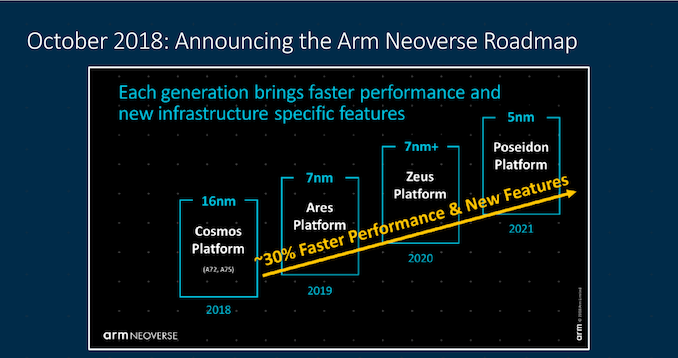
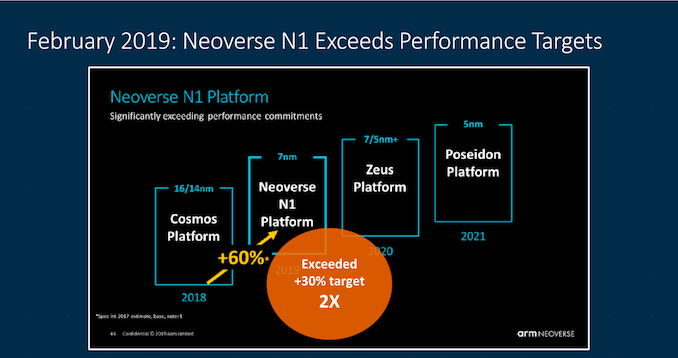
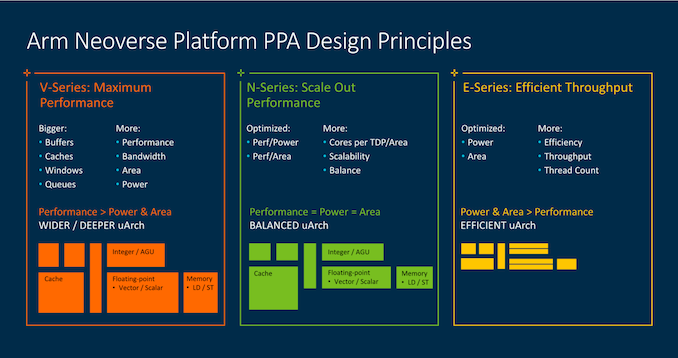
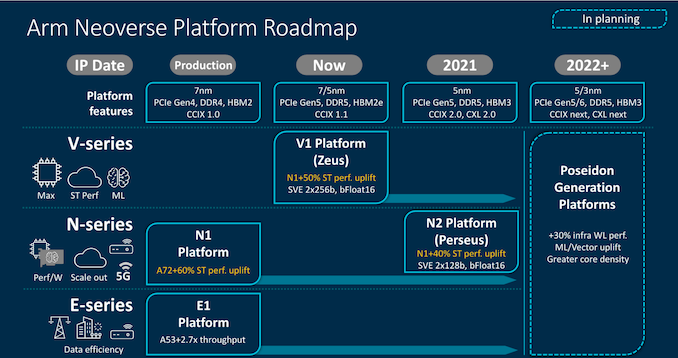
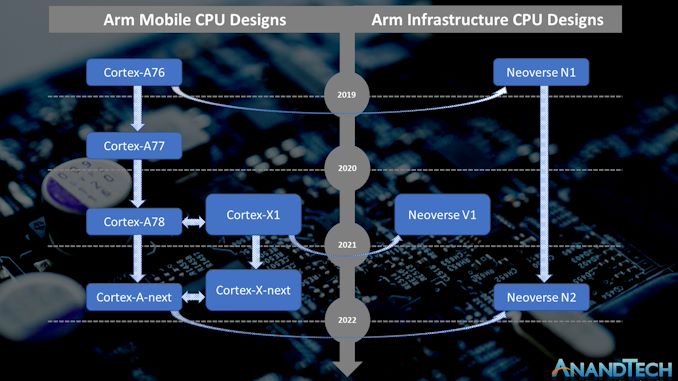
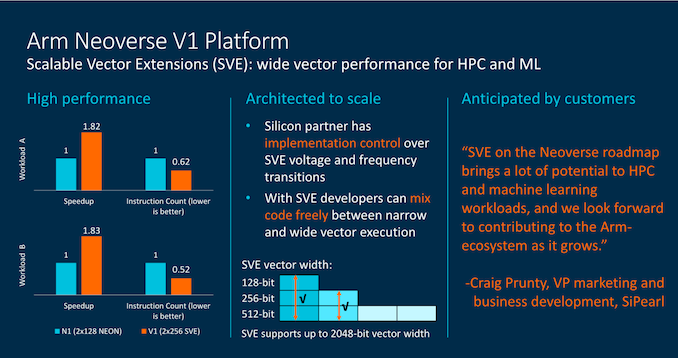
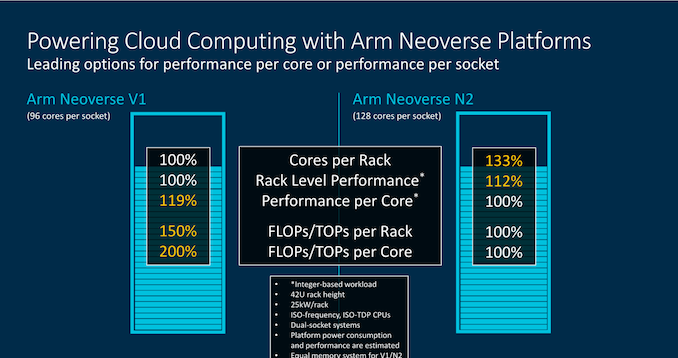
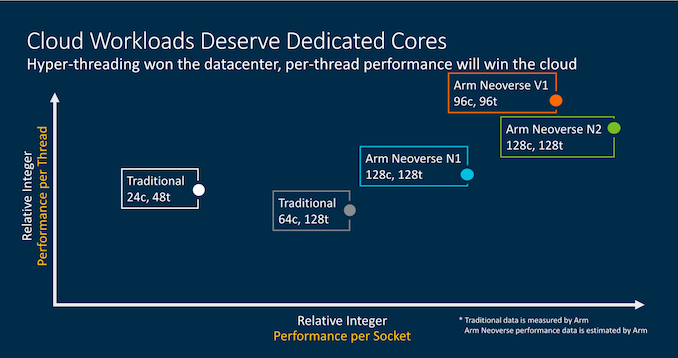








74 Comments
View All Comments
Dex4Sure - Wednesday, September 23, 2020 - link
AMD fanboy delusion going rabid in your mind. When Amazon is pushing ARM, and Amazon literally controls most of the servers (AWS) they can move their ecosystem over to ARM if they truly want. And there's nothing AMD can do about it. X86 is a legacy architecture on its way out.dotjaz - Sunday, September 27, 2020 - link
That's really dumb claim. Graviton2 is good. No doubt about it. But AWS can't just switch to ARM no matter how much "truly" they wanted it. The market and eco system is just not there yet. You are no better than the AMD fanboy.nvidiot101 - Tuesday, March 22, 2022 - link
""AMD really needs to establish itself as something other than low-cost to survive the onslaught of coming competitors.""Someone explain to this nvidiot that Amd projects to make 21B in revenue this year and if continues to grow like the last years, which is probable having bought Xilinx, AMD will be making more money that Intel and Nvidia combined. Maybe is Intel and Nvidia that should go low cost? Ever think about that? AMD Ryzen 8000, their hybrid arch is coming in a year and a half and anyone not a delusional fanboy knows its going to destroy all the competition. I mean "efficient" alder lake cores are less efficient than zen2, good luck competing with zen4d and Zen5 performance cores. Really AMD needs to go low cost? Talk about delusion.
And good luck with Nvidia buying Arm lol, so with Arm becoming more successful and with bigger market share, the people that blocked the merger will allow it now. Talking about DELUSION!!
michael2k - Wednesday, September 23, 2020 - link
Between ARM, Mellanox, and GeForce, NVIDIA is positioned to start owning supercomputer designs.They already have a top 10 (7th place) design using AMD's Epyc Mellanox Infiniband switches, and of course NVIDIA's A100 GPUs.
I don't see why they wouldn't replace AMD with ARM given they already have ARM base products, they just needed an ARM core that was equivalent to the best AMD and Intel could offer.
bigvlada - Tuesday, September 22, 2020 - link
IBM, Apple and Motorola thought the same with Power PC cpus, along with DEC Alpha, Sun Sparc and Silicon Graphics with MIPS processors. All of them are now nice museum pieces. I remember first tests when then monstrous DEC Alpha cpu executed x86 software with speed comparable to 80286 due to software emulation.Arm does not have some inherent architectural advantage over x86. It needs to be drastically better and execute all x86 software notably faster in order to replace the x86. That won't happen.
On the other hand, while assaulting x86 on all fronts Arm (not by its own doing) left his sides and back unguarded. If Nvidia buys them, they lose their most potent characteristic, the status of neutral Switzerland in semiconductor industry. Chinese companies won't use the architecture if their access to it could be blocked in the future due to the fact that it would be an american company. Europeans would also hesitate using it if they would be unable to sell it to Chinese companies.
RISC-V is years behind the Arm ecosystem but it is an open hardware architecture, meaning there are no restrictions in using it. I would assume that due to the Nvidias past behavior all the large Arm buyers will invest heavily in RISC-V and use Arm only as long as absolutely necessary.
Tabalan - Tuesday, September 22, 2020 - link
Well, Anandetch benchmarks showcase that ARM has quite huge perf/W advantage over x86. Will love to see Apple ARM Silicon vs Icelake or other Lake.Also, don't see everyone jumping ARM ship just because Nvidia might/will buy them. Chinese companies can use ARM even after Americans buy them (as long as they aren't banned), they will just pay more focus to tweaking core, I/O and so on. Or maybe even go full custom core.
gescom - Tuesday, September 22, 2020 - link
"Chinese companies can use ARM even after Americans buy them (as long as they aren't banned)"Thanks but no thanks for this kind of offer.
Tabalan - Tuesday, September 22, 2020 - link
Well, if you apply this thinking they should try to avoid Intel, AMD, Nvidia, MS, Google and other American giant corporations.Railander - Tuesday, September 22, 2020 - link
dont they already? last i checked many services of the companies you listed have already been blocked at the Great Firewall for many years.omi-kun - Tuesday, September 22, 2020 - link
You're likely right in that the architectural difference is minor, but the devil is in the details (uarch in this case). If you look at the nuvia article, they showed arm has ~4x better perf/watt in geekbench over Intel/AMD. While that's not a definitive benchmark it shows a huge lead on the arm side.While Apple's cpus are already faster than Intel in some sense, ARM really just needs the better perf/watt to take over laptop and servers, where efficiency is still king. Imagine a laptop that's 2x lower TDP with the same perf. You use less board space, less VRMs, smaller battery. You get ultrabook form factor with gaming perf. That's a game changer.